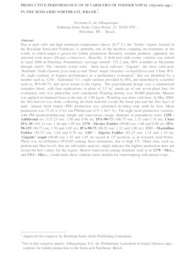Productive performance of 20 varieties of fodder nopal (Opuntia spp.) in the semi-arid Northeast, Brazil.
Productive performance of 20 varieties of fodder nopal (Opuntia spp.) in the semi-arid Northeast, Brazil.
Autoria: ALBUQUERQUE, S. G. de
Resumo: Due to poor soils and high minimum temperature (above 20.5o C), the ‘Sertão’ region, located in the Brazilian Semi-arid Northeast, is probably one of the harshest cropping environments in the world, in which nopal i s grown for f odder production. Recently, another problem appeared, the armored scale insect (Diaspis echinocacti - Bouchè). A field trial with twenty varieties was started in April 2000 in Petrolina, Pernambuco, (average rainfall 552.2 mm, 80% available in December through April). The varieties tested were: three local cultivars, ‘Gigante’, the most cultivated, ‘Redonda’ (both Opuntia ficus-indica) and ‘Doce’ nopal (Nopalea cochenillifera) and Clone IPA- 20, eight varieties of highest performance in a preliminary evaluation2, that are identified by a number such as, 1258 - Additional Cv.; eight varieties provided by IPA, and identified by a number such as, IPA-90-73, and n ever tested in the region.. The e xperimental design was, a randomized complete block, with four replications, in p lots of 3.5 m2, made up o f one seven-plant li ne, for evaluation, on ly five plants/line were c onsidered. Planting density was 20.000 p lants/ha. Manure was applied on biannual basis at the rate of 2.86 kg/m.. Weeding was done with hoes. In May 2004, the first harvest was done, collecting all fresh material except t he basal pad and the first l ayer of pads. Annual fresh matter (FM) production was calculated d ividing total yield by four. Mean production was 75.24 ± 33.61 ton FM/ha/year (CV = 44.7 %). The eight most productive varieties, with FM production/ha/year, h eight and transversal canopy diameter in p arenthesis were: 1258 - Additional cv. (115.25 ton; 1.50 and 0.96 m); IPA-90-73 (106.75 ton; 1.53 and 1.16 m); Clone IPA-20 (101.12 ton; 1.46 and 1.09 m); 1278 - Mexico Fodder (99.00 ton; 1.68 and 0.88 m); IPA- 90-155 (96.75 ton; 1.50 and 1.05 m); IPA-90-75 (86.92 ton; 1.32 and 1.00 m); 1311 - Marmillon Fodder (85.55 ton; 1.64 and 0.78 m); 1267 - Algeria Fodder (85.25 ton; 1.18 and 1.18 m). ‘Gigante’ nopal (68.00 ton; 1.43 and 1.05 m) stayed in 13 o position, as in research cited b elow. There was no d ifference (P<0.05) among these treatments, du e to h igh CV. Other data, such as, protein and fiber levels, that are still under analysis, might indicate that highest production does not assure the best variety for the region. Shorter transversal canopy diameter such as in 1278 - Mex... and 1311 - Mar..., would make these varieties more suitable for intercropping with annual crop
Ano de publicação: 2004
Tipo de publicação: Resumo em anais e proceedings
Unidade: Embrapa Semiárido
Palavras-chave: Nordeste, Opuntia spp, Palma, Produção, Região semi-árida, Variedade
Observações
1 - Por padrão são exibidas publicações dos últimos 20 anos. Para encontrar publicações mais antigas, configure o filtro ano de publicação, colocando o ano a partir do qual você deseja encontrar publicações. O filtro está na coluna da esquerda na busca acima.
2 - Para ler algumas publicações da Embrapa (apenas as que estão em formato ePub), é necessário ter, no celular ou computador, um desses softwares gratuitos. Sistemas Android: Google Play Livros; IOS: iBooks; Windows e Linux: software Calibre.
Acesse outras publicações
Acesse a Base de Dados da Pesquisa Agropecuária (BDPA) para consultar o acervo completo das bibliotecas da Embrapa.

